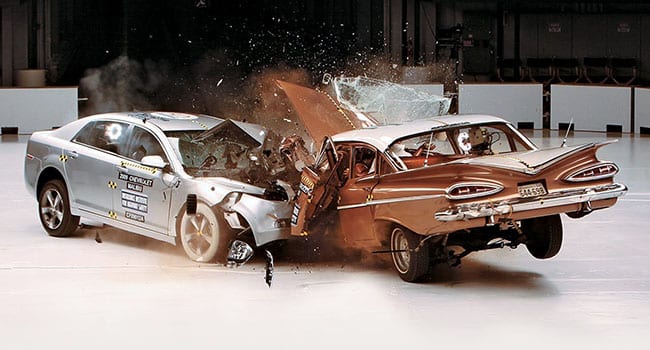
In a dramatic video that made the rounds on the Internet a few years ago, a 2009 Chevrolet Malibu is crashed into a 1959 Chev Bel Air in a front offset collision staged by the Insurance Institute for Highway Safety (IIHS). A person in the 1959 car would likely have died. Anyone in the 2009 vehicle would have fared much better.
 In a dramatic video that made the rounds on the Internet a few years ago, a 2009 Chevrolet Malibu is crashed into a 1959 Chev Bel Air in a front offset collision staged by the Insurance Institute for Highway Safety (IIHS).
In a dramatic video that made the rounds on the Internet a few years ago, a 2009 Chevrolet Malibu is crashed into a 1959 Chev Bel Air in a front offset collision staged by the Insurance Institute for Highway Safety (IIHS).
Despite the prevailing wisdom that older automobiles, with their heavier construction and greater use of steel, are structurally stronger than new models, the ’59 Chevy doesn’t fare so well.
In fact, had there been a real person behind the wheel, they would likely have perished.
The occupant of the Malibu, on the other hand, would have – theoretically, at least – escaped with a broken leg and various bumps and bruises.
In the video, both cars are destroyed but the older Chev definitely gets the worst of it.
This is thanks to safety technology such as seatbelts, airbags and crumple zones. Today’s breed of automobiles have these features as a matter of course, plus other life-savers such as anti-locking brakes, traction control systems and vehicle stability systems.
But there’s more. Manufacturers such as Audi, Nissan, Ford, Honda and others now implement active safety features that make the driving experience even safer, and add features year after year. Here are some safety features that can definitely make a difference:
Lane departure warning
Through the use of various sensors, the driver is alerted that he or she has strayed from their traffic lane. Depending on the manufacturer, the driver will either be alerted to take action or the vehicle will be automatically guided back into the correct lane, often through the use of the anti-locking brakes.
In the case of Honda, for example, a camera keeps track of the road ahead and monitors the driver’s position in traffic.
Automotive night vision
With more and more baby boomers entering their golden years, night driving has become more problematic than ever. Many manufacturers, therefore, are offering enhanced headlight systems that provide brighter illumination than conventional systems.
Honda’s Intelligent Night Vision, for example, can detect infrared light from far away and provides both an audible warning and a visual alert on the instrument display to lessen the chances of hitting a pedestrian or wildlife.
Collision avoidance
Also known as collision mitigation, collision warning or pre-crash warning, this prepares the automobile in the event of an unavoidable front-ender.
Depending on the manufacturer, this is achieved through the use of a camera or front-end sensors. If things are about to get ugly, it will apply the brakes automatically and tighten the seatbelts. In the case of Audi, for example, this system will also close all the windows and sunroof, and apply the brakes progressively.
Blind spot warning
Through the use of cameras or sensors, the vehicle can detect if there’s another vehicle in its blind spot – when changing lanes, for example.
Usually, if there’s another vehicle present, small warning lights in the outside mirrors will flash, alerting the driver. Some manufacturers also utilize audible warnings.
This feature, first introduced in 2007, is now widespread throughout the industry.
Drowsiness alert
This fascinating innovation keeps tabs on the drivers’ state of alertness, and provides an audible or visual warning that they’re becoming inattentive.
Some manufacturers use a system that monitors the vehicle’s progress in traffic, monitoring things like speed, lane position and so on. Others use a camera trained on the driver to follow their driving performance. Start to drift off into the land of nod and you’ll either be jolted awake by a buzzer or chimes.
Some carmakers also have a visual signal that appears on the instrument cluster – a coffee cup, for example – should your mind start to wander.
Vehicle perimeter cameras
By now, backup cameras that aid in parallel parking are widespread throughout the industry. But some manufacturers – Nissan, for one – have vehicle perimeter cameras that provide instant views on all four corners of the car. This allows the driver to visually confirm the vehicle’s position and makes the parking experience that much simpler.
Cross traffic alert
This system, often used in conjunction with the blind spot warning system, monitors traffic and obstacles around the car while it’s moving slowly – backing out of a driveway or parking spot, for example.
In the case of the Ford Taurus, for example, a radar system can detect a vehicle approaching from the left or the right up to 14 metres away. It will then send the driver an audible warning, a visual display in the side view mirror and a signal in the message centre.
Aside from the fact that there are more cars than ever on the roads, studies show that the vast majority of accidents are caused by driver inattentiveness and/or negligence.
Unfortunately, that’s one problem that will never be completely eradicated. You can’t cure stupid.
Ted Laturnus writes for Troy Media’s Driver Seat Associate website. An automotive journalist since 1976, he has been named Canadian Automotive Journalist of the Year twice and is past-president of the Automotive Journalists Association of Canada (AJAC).
The views, opinions and positions expressed by columnists and contributors are the author’s alone. They do not inherently or expressly reflect the views, opinions and/or positions of our publication.
